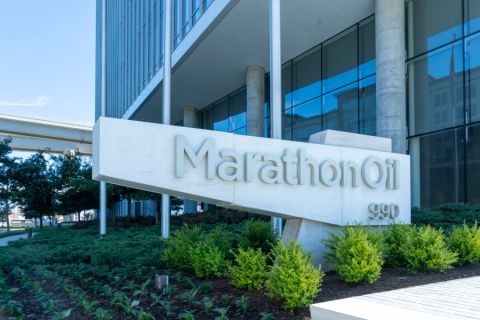New technology is expected in 2024 from the multiyear three-way collaboration among Amazon Web Services (AWS), Shell Global Solutions Nederland BV and SLB as part of efforts to accelerate digital solutions in the subsurface.
SLB on Oct. 10 announced an agreement to deliver digital end-to-end workflows using Open Subsurface Data Universe (OSDU) data platform standards for Shell using SLB subsurface solutions on AWS cloud infrastructure. The platform gathers and stores all data in one centralized cloud solution.
Shell said in a press release that it aimed to accelerate the arrival of those cloud solutions and enable OSDU Data Platform access. Trygve Randen, senior vice president for digital products and solutions at SLB, told Hart Energy the partnership could become a beacon for OSDU adoption.
“OSDU is becoming real, and then that will drive more adoption of the OSDU environment,” he said. “We have traditionally been an industry which has been locked into silos. OSDU kind of flattens the competitive landscape, and for us and many others, that's an opportunity to be able to demonstrate the strength of our tools in that environment.”
Hussein Shel, director, chief technologist and head of upstream at AWS, told Hart Energy the collaboration will help accelerate the value that digital technologies can provide for the subsurface.

AWS, Shell and SLB are no strangers to working together. They were among the early members of the Open Group Forum, which has a stated vision of “boundary-less information flow achieved through global interoperability in a secure, reliable and timely manner,” that lead to the creation of the OSDU.
And while the collaboration will allow AWS and SLB to deliver value to Shell, the companies will also be able to make that value available to the wider industry in the future, Shel said.
“Because of this collaboration, the industry will have more options when it comes to adopting innovative SLB digital subsurface solutions, but also other [AWS] partners’ innovative solutions, which is the flexibility needed to accelerate that overall value that digital can provide and deliver in subsurface,” he said.
The collaboration will enable workflows that are more flexible than in the past, he said, which will give customers room for experimentation. The collaboration also introduces capabilities such as machine learning and artificial intelligence (AI), where AWS and other cloud providers are constantly innovating, he said.
It makes it “easy for them to adopt because it's all being built on this open-ended industry standard,” Shel said.
‘Not magic’
The collaboration builds on the existing strategic collaboration agreement between SLB and AWS and accelerates the availability of SLB’s software, including Petrel subsurface solutions and Techlog wellbore solutions.
Shel said the collaboration is still in the early stages, but all three parties have deployed dedicated resources across the different streams of projects to be delivered in the near-term, with scoping in progress for longer-term outcomes.
“There's multiple horizons for this collaboration, as you can imagine, starting with what can be accomplished today given the current technologies and the current capabilities and what can be accomplished in the next three to five years across the three companies’ roadmaps,” he said.

SLB’s Randen said an initial goal is to have the first pieces of technology ready for adoption early next year.
“OSDU is a great promise for the industry, but it's not magic,” Randen said. “There is still real work that needs to be done to operationalize the service. We're talking here about being able to run rich workflows in a new type of environment that requires cloud service level agreements and so much more to be put in place.”
Getting there will take a bit of work. One reason: OSDU is implemented slightly differently on each cloud provider’s platform.
To date, SLB has mostly worked with Microsoft Azure for cloud services. SLB will need to ensure that its services will work properly on the AWS cloud, he said.
Shel said each cloud provider has its own ways of implementing OSDU standards to take advantage of underlying infrastructure, services and strengths.
“But at the end of the day, application A talks to application B using the OSDU API [Application Programming Interface], storing the OSDU schema and running on the OSDU data formats—and are all compliant and based on OSDU principles and standards,” he said.
For AWS, differentiators include Amazon Simple Storage Service (Amazon S3) for object storage and Amazon Elastic Compute Cloud (Amazon EC2), among others, he said.
AI and machine learning offer significant potential to transform Shell’s—and the industry’s—workload, Randen said.
“The industry cannot continue working in the same heavy duty way it has been working in the past. Across the entire spectrum of everything we're doing, from data interpretation to building models to optimizing how we run these models … AI has a huge potential for transforming the work,” he said.
That’s something SLB and others have been working on for years.
“But we're still just scratching the surface of what we possibly can be doing in helping drive efficiencies,” he said.
Efficiencies help people produce results faster and could help reduce risk in new ways, he said.
“Our industry has typically been working with situations that are highly uncertain, highly inaccurate,” Randen said. “There's a [joke] saying that … we know that every model is wrong, but some models are useful, and being able to extract more models faster is going to help us to get more of that usefulness out.
“Because if every model is wrong, then we need to look at multiple models—and that's one of the areas where there's a lot of work left to be done for the industry to optimize.”
Recommended Reading
Keeping it Simple: Antero Stays on Profitable Course in 1Q
2024-04-26 - Bucking trend, Antero Resources posted a slight increase in natural gas production as other companies curtailed production.
Oil and Gas Chain Reaction: E&P M&A Begets OFS Consolidation
2024-04-26 - Record-breaking E&P consolidation is rippling into oilfield services, with much more M&A on the way.
Exxon Mobil, Chevron See Profits Fall in 1Q Earnings
2024-04-26 - Chevron and Exxon Mobil are feeling the pinch of weak energy prices, particularly natural gas, and fuels margins that have cooled in the last year.
Marathon Oil Declares 1Q Dividend
2024-04-26 - Marathon Oil’s first quarter 2024 dividend is payable on June 10.
Talos Energy Expands Leadership Team After $1.29B QuarterNorth Deal
2024-04-25 - Talos Energy President and CEO Tim Duncan said the company has expanded its leadership team as the company integrates its QuarterNorth Energy acquisition.





